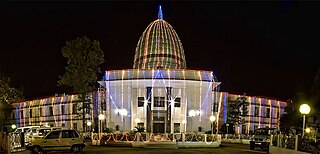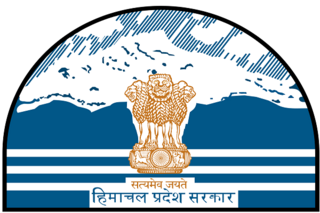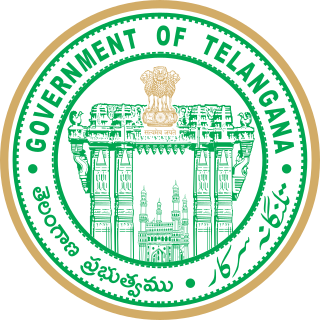Related Research Articles

Itanagar is the capital and largest town of the Indian state of Arunachal Pradesh. The seat of Arunachal Pradesh Legislative Assembly, the seat of government of Arunachal Pradesh, and the seat of Gauhati High Court permanent bench at Naharlagun are all in Itanagar. Being the hub of all the major economic bases, Itanagar, along with the adjacent town of Naharlagun, comprise the administrative region of the Itanagar Capital Complex Region. This stretches from the Itanagar Municipal limit at Chandranagar Town extended until Nirjuli Town, and is a major junction of cultural, economic, fashion, education and recreational activities.

The Gauhati High Court was promulgated by governor general of India on 1 March 1948 after the Government of India Act 1935 was passed, establishing the high court with effect from 5 April 1948, for the then-province of Assam. It was originally known as the High Court of Assam and Nagaland, but renamed as Gauhati High Court in 1971 by the North-Eastern Areas (Reorganisation) Act, 1971.
The Government of Rajasthan is the supreme governing authority of the Indian state of Rajasthan and its 50 districts. It consists of an executive branch, led by the governor of Rajasthan, as well as judiciary and legislative branches. Jaipur is the capital of Rajasthan, and houses the Vidhan Sabha and the secretariat.

The Government of Himachal Pradesh also known as the State Government of Himachal Pradesh, or locally as State Government, is the supreme governing authority of the Indian state of Himachal Pradesh. It consists of an executive branch, led by the Governor of Himachal Pradesh, a judiciary and a legislative branch.
The Government of Uttar Pradesh is the subnational government of the Indian state of Uttar Pradesh with the governor as its appointed constitutional head of the state by the President of India. The Governor of Uttar Pradesh is appointed for a period of five years and appoints the Chief Minister of Uttar Pradesh and their council of ministers, who are vested with the executive powers of the state. The governor remains a ceremonial head of the state, while the chief minister and their council are responsible for day-to-day government functions.

The Government of Bihar or Bihar Government is the state government of the Indian state of Bihar and its 9 divisions which consist of 38 districts. It consists of an executive, led by the Governor of Bihar, a judiciary and legislative branches.

The Government of Gujarat, also known as GujaratGovernment, is the supreme governing authority of the Indian state of Gujarat and its 33 districts. It consists of an executive of the legislators appointed by the Governor of Gujarat, a judiciary and of a publicly elected legislative body.
Government of Madhya Pradesh also known as the State Government of Madhya Pradesh, or locally as the Madhya Pradesh Government, is the supreme governing authority of the Indian state of Madhya Pradesh and its 55 districts. It consists of an executive, led by the governor of Madhya Pradesh, a judiciary and a legislative branch. In 2000, the southern portion was broken off to form the new state of Chhattisgarh with its own government.

The Government of Mizoram also known as the State Government of Mizoram, or locally as State Government, is the supreme governing authority of the Indian state of Mizoram and its 11 districts. It consists of an executive, led by the Governor of Mizoram, a judiciary and a legislative branch.
The Government of Nagaland also known as the State Government of Nagaland, or locally as State Government, is the governing authority of the India state of Nagaland and its 16 districts. It consists of an executive, led by the Governor of Nagaland, a judiciary and a legislative branch. Kohima is the capital of Nagaland, and houses the Vidhan Sabha and the secretariat.
State governments in India are the governments ruling over 28 states and 8 union territories of India and the head of the Council of Ministers in a state is the Chief Minister. Power is divided between the Union government and state governments. While the Union government handles defence, external affairs etc., the state government deals with internal security and other state issues. Income for the Union government is from customs duty, excise tax, income tax etc., while state government income comes from sales tax (VAT), stamp duty etc.; now these have been subsumed under the various components of the Goods and Services Tax

Papum Pare district is an administrative district in the state of Arunachal Pradesh in India. As of 2011, it is the most populous district of Arunachal Pradesh.

The Government of Telangana also known as TelanganaGovernment, is the governing authority of the state of Telangana in India. It consists of an executive, a judiciary and a legislative.
The Arunachal Pradesh Legislative Assembly is the unicameral state legislature of Arunachal Pradesh state in north-eastern India. The seat of the Legislative Assembly is at Itanagar, the capital of the state. The Legislative Assembly comprises 60 Members of Legislative Assembly directly elected from single-seat constituencies.

The following outline is provided as an overview of and topical guide to Arunachal Pradesh:
Starting April 2015, the Indian state of Arunachal Pradesh underwent a political crisis. The Indian National Congress Chief Minister Nabam Tuki replaced Jarbom Gamlin as the Chief Minister of Arunachal Pradesh on 1 November 2011 and continued till January 2016. After a political crisis in 2016, the President's rule was imposed ending his tenure as the chief minister. In February 2016, Kalikho Pul became the Chief Minister when 14 disqualified MLAs were reinstated by the Supreme Court. On 13 July 2016, the Supreme Court quashed the Arunachal Pradesh Governor J.P. Rajkhowa’s order to advance the Assembly session from 14 January 2016 to 16 December 2015, which resulted in President's rule in Arunachal Pradesh. As a result, Tuki was restored as the Chief Minister of Arunachal Pradesh on 13 July 2016. But hours before proving majority, he resigned as the Chief Minister on 16 July 2016. He was succeeded by Pema Khandu as the INC Chief Minister but later joined PPA in September 2016 along with majority MLAs. He further joined BJP in December 2016 along with majority MLAs.

Hrishikesh Roy is a judge of the Supreme Court of India. He is former Chief Justice of the Kerala High Court. He is also former judge of the Gauhati High Court.
Justice Arup Kumar Goswami is an Indian Judge. He is the former Chief Justice of Chhattisgarh High Court, Andhra Pradesh High Court and Sikkim High Court and Judge of Gauhati High Court.
Biyuram Wahge is an Indian politician from Arunachal Pradesh. He is a member of the Bharatiya Janata Party and the president of state's BJP unit. He is a member of the Arunachal Pradesh Legislative Assembly representing Pakke-Kessang constituency.
Arunachal Pradesh Lokayukta is the Parliamentary Ombudsman for the state of Arunachal Pradesh (India). It is a high level statutory functionary, created to address grievances of the public against ministers, legislators, administration and public servants in issues related to misuse of power, mal-administration and corruption. It was first formed under the Arunachal Pradesh Lokayukta and Deputy Lokayukta Act-2014 and approved by the president of India. The passage of The Lokpal and Lokayuktas Act, 2013 in Parliament had become law from January 16, 2014 and requires each state to appoint its Lokayukta within a year. A bench of Lokayukta should consist of judicial and non-judicial members. An Upa-Lokayukta is a deputy to Lokayukta and assists him in his work and acts in-charge Lokayukta in case the position fells vacant before time.
References
- ↑ "Itanagar Permanent Bench". The Gauhati High Court. Government of India. Retrieved 12 May 2008.